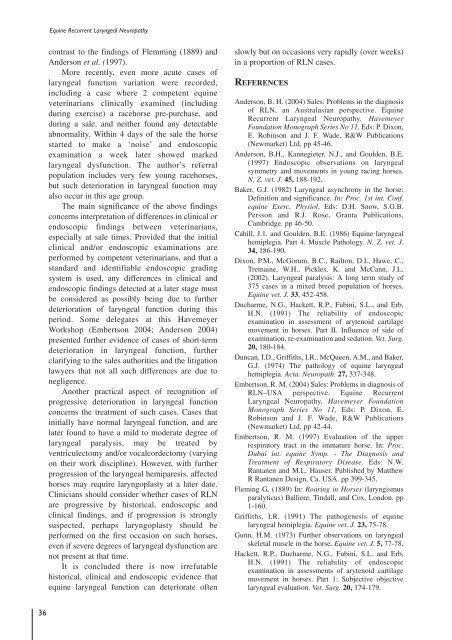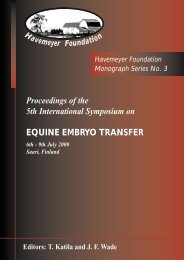Proceedings of a Workshop on - The Havemeyer Foundation
Proceedings of a Workshop on - The Havemeyer Foundation
Proceedings of a Workshop on - The Havemeyer Foundation
You also want an ePaper? Increase the reach of your titles
YUMPU automatically turns print PDFs into web optimized ePapers that Google loves.
Equine Recurrent Laryngeal Neuropathy<br />
c<strong>on</strong>trast to the findings <str<strong>on</strong>g>of</str<strong>on</strong>g> Flemming (1889) and<br />
Anders<strong>on</strong> et al. (1997).<br />
More recently, even more acute cases <str<strong>on</strong>g>of</str<strong>on</strong>g><br />
laryngeal functi<strong>on</strong> variati<strong>on</strong> were recorded,<br />
including a case where 2 competent equine<br />
veterinarians clinically examined (including<br />
during exercise) a racehorse pre-purchase, and<br />
during a sale, and neither found any detectable<br />
abnormality. Within 4 days <str<strong>on</strong>g>of</str<strong>on</strong>g> the sale the horse<br />
started to make a ‘noise’ and endoscopic<br />
examinati<strong>on</strong> a week later showed marked<br />
laryngeal dysfuncti<strong>on</strong>. <strong>The</strong> author’s referral<br />
populati<strong>on</strong> includes very few young racehorses,<br />
but such deteriorati<strong>on</strong> in laryngeal functi<strong>on</strong> may<br />
also occur in this age group.<br />
<strong>The</strong> main significance <str<strong>on</strong>g>of</str<strong>on</strong>g> the above findings<br />
c<strong>on</strong>cerns interpretati<strong>on</strong> <str<strong>on</strong>g>of</str<strong>on</strong>g> differences in clinical or<br />
endoscopic findings between veterinarians,<br />
especially at sale times. Provided that the initial<br />
clinical and/or endoscopic examinati<strong>on</strong>s are<br />
performed by competent veterinarians, and that a<br />
standard and identifiable endoscopic grading<br />
system is used, any differences in clinical and<br />
endoscopic findings detected at a later stage must<br />
be c<strong>on</strong>sidered as possibly being due to further<br />
deteriorati<strong>on</strong> <str<strong>on</strong>g>of</str<strong>on</strong>g> laryngeal functi<strong>on</strong> during this<br />
period. Some delegates at this <strong>Havemeyer</strong><br />
<str<strong>on</strong>g>Workshop</str<strong>on</strong>g> (Emberts<strong>on</strong> 2004; Anders<strong>on</strong> 2004)<br />
presented further evidence <str<strong>on</strong>g>of</str<strong>on</strong>g> cases <str<strong>on</strong>g>of</str<strong>on</strong>g> short-term<br />
deteriorati<strong>on</strong> in laryngeal functi<strong>on</strong>, further<br />
clarifying to the sales authorities and the litigati<strong>on</strong><br />
lawyers that not all such differences are due to<br />
negligence.<br />
Another practical aspect <str<strong>on</strong>g>of</str<strong>on</strong>g> recogniti<strong>on</strong> <str<strong>on</strong>g>of</str<strong>on</strong>g><br />
progressive deteriorati<strong>on</strong> in laryngeal functi<strong>on</strong><br />
c<strong>on</strong>cerns the treatment <str<strong>on</strong>g>of</str<strong>on</strong>g> such cases. Cases that<br />
initially have normal laryngeal functi<strong>on</strong>, and are<br />
later found to have a mild to moderate degree <str<strong>on</strong>g>of</str<strong>on</strong>g><br />
laryngeal paralysis, may be treated by<br />
ventriculectomy and/or vocalcordectomy (varying<br />
<strong>on</strong> their work discipline). However, with further<br />
progressi<strong>on</strong> <str<strong>on</strong>g>of</str<strong>on</strong>g> the laryngeal hemiparesis, affected<br />
horses may require laryngoplasty at a later date.<br />
Clinicians should c<strong>on</strong>sider whether cases <str<strong>on</strong>g>of</str<strong>on</strong>g> RLN<br />
are progressive by historical, endoscopic and<br />
clinical findings, and if progressi<strong>on</strong> is str<strong>on</strong>gly<br />
suspected, perhaps laryngoplasty should be<br />
performed <strong>on</strong> the first occasi<strong>on</strong> <strong>on</strong> such horses,<br />
even if severe degrees <str<strong>on</strong>g>of</str<strong>on</strong>g> laryngeal dysfuncti<strong>on</strong> are<br />
not present at that time.<br />
It is c<strong>on</strong>cluded there is now irrefutable<br />
historical, clinical and endoscopic evidence that<br />
equine laryngeal functi<strong>on</strong> can deteriorate <str<strong>on</strong>g>of</str<strong>on</strong>g>ten<br />
slowly but <strong>on</strong> occasi<strong>on</strong>s very rapidly (over weeks)<br />
in a proporti<strong>on</strong> <str<strong>on</strong>g>of</str<strong>on</strong>g> RLN cases.<br />
REFERENCES<br />
Anders<strong>on</strong>, B. H. (2004) Sales: Problems in the diagnosis<br />
<str<strong>on</strong>g>of</str<strong>on</strong>g> RLN, an Australasian perspective. Equine<br />
Recurrent Laryngeal Neuropathy. <strong>Havemeyer</strong><br />
Foundati<strong>on</strong> M<strong>on</strong>ograph Series No 11, Eds: P. Dix<strong>on</strong>,<br />
E. Robins<strong>on</strong> and J. F. Wade, R&W Publicati<strong>on</strong>s<br />
(Newmarket) Ltd, pp 45-46.<br />
Anders<strong>on</strong>, B.H., Kannegieter, N.J., and Goulden, B.E.<br />
(1997) Endoscopic observati<strong>on</strong>s <strong>on</strong> laryngeal<br />
symmetry and movements in young racing horses.<br />
N. Z. vet. J. 45, 188-192.<br />
Baker, G.J. (1982) Laryngeal asynchr<strong>on</strong>y in the horse:<br />
Definiti<strong>on</strong> and significance. In: Proc. 1st int. C<strong>on</strong>f.<br />
equine Exerc. Physiol, Eds: D.H. Snow, S.G.B.<br />
Perss<strong>on</strong> and R.J. Rose, Granta Publicati<strong>on</strong>s,<br />
Cambridge. pp 46-50.<br />
Cahill, J.1. and Goulden, B.E. (1986) Equine laryngeal<br />
hemiplegia. Part 4. Muscle Pathology. N. Z. vet. J.<br />
34, 186-190.<br />
Dix<strong>on</strong>, P.M., McGorum, B.C., Railt<strong>on</strong>, D.I., Hawe, C.,<br />
Tremaine, W.H., Pickles, K. and McCann, J.L.<br />
(2002). Laryngeal paralysis: A l<strong>on</strong>g term study <str<strong>on</strong>g>of</str<strong>on</strong>g><br />
375 cases in a mixed breed populati<strong>on</strong> <str<strong>on</strong>g>of</str<strong>on</strong>g> horses.<br />
Equine vet. J. 33, 452-458.<br />
Ducharme, N.G., Hackett, R.P., Fubini, S.L., and Erb,<br />
H.N. (1991) <strong>The</strong> reliability <str<strong>on</strong>g>of</str<strong>on</strong>g> endoscopic<br />
examinati<strong>on</strong> in assessment <str<strong>on</strong>g>of</str<strong>on</strong>g> arytenoid cartilage<br />
movement in horses. Part II. Influence <str<strong>on</strong>g>of</str<strong>on</strong>g> side <str<strong>on</strong>g>of</str<strong>on</strong>g><br />
examinati<strong>on</strong>, re-examinati<strong>on</strong> and sedati<strong>on</strong>. Vet. Surg.<br />
20, 180-184.<br />
Duncan, I.D., Griffiths, I.R., McQueen, A.M., and Baker,<br />
G.J. (1974) <strong>The</strong> pathology <str<strong>on</strong>g>of</str<strong>on</strong>g> equine laryngeal<br />
hemiplegia. Acta. Neuropath. 27, 337-348.<br />
Emberts<strong>on</strong>, R. M. (2004) Sales: Problems in diagnosis <str<strong>on</strong>g>of</str<strong>on</strong>g><br />
RLN–USA perspective. Equine Recurrent<br />
Laryngeal Neuropathy. <strong>Havemeyer</strong> Foundati<strong>on</strong><br />
M<strong>on</strong>ograph Series No 11, Eds: P. Dix<strong>on</strong>, E.<br />
Robins<strong>on</strong> and J. F. Wade, R&W Publicati<strong>on</strong>s<br />
(Newmarket) Ltd, pp 42-44.<br />
Emberts<strong>on</strong>, R. M. (1997) Evaluati<strong>on</strong> <str<strong>on</strong>g>of</str<strong>on</strong>g> the upper<br />
respiratory tract in the immature horse. In: Proc.<br />
Dubai int. equine Symp. - <strong>The</strong> Diagnosis and<br />
Treatment <str<strong>on</strong>g>of</str<strong>on</strong>g> Respiratory Disease. Eds: N.W.<br />
Rantanen and M.L. Hauser. Published by Matthew<br />
R Rantanen Design, Ca. USA. pp 399-345.<br />
Fleming G. (1889) In: Roaring in Horses (laryngismus<br />
paralyticus) Balliere, Tindall, and Cox, L<strong>on</strong>d<strong>on</strong>. pp<br />
1-160.<br />
Griffiths, I.R. (1991) <strong>The</strong> pathogenesis <str<strong>on</strong>g>of</str<strong>on</strong>g> equine<br />
laryngeal hemiplegia. Equine vet. J. 23, 75-78.<br />
Gunn, H.M. (1973) Further observati<strong>on</strong>s <strong>on</strong> laryngeal<br />
skeletal muscle in the horse. Equine vet. J. 5, 77-78.<br />
Hackett, R.P., Ducharme, N.G., Fubini, S.L. and Erb,<br />
H.N. (1991) <strong>The</strong> reliability <str<strong>on</strong>g>of</str<strong>on</strong>g> endoscopic<br />
examinati<strong>on</strong> in assessments <str<strong>on</strong>g>of</str<strong>on</strong>g> arytenoid cartilage<br />
movement in horses. Part 1: Subjective objective<br />
laryngeal evaluati<strong>on</strong>. Vet. Surg. 20, 174-179.<br />
36








